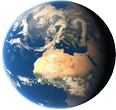




| Copacabana is a quiet little town on the shores of Lake Titicaca close to the Bolivian border. There is an impresive white church in town and of course the town harbours a little beach which its more famous big brother in Rio the Janeiro is named after. From Copacabana you can make nice day trips to Isla del Sol (Island of the sun) where there are old Inca and pre-Inca ruins. |

| At 3600m above sealevel, La Paz is the highest capital in the world. As a result, it's always chilly and windy, which don't make it very welcoming at first sight. However, it's a very vibrant city where everything happens on the streets. Litteraly everything can be bought on markets or stands scattered throughout the city. In addition, there are several interesting museums like the tihuanacu muesum and the coca museum. From La Paz you can make lots of nice daytrips: You can visit the surrealistic Valle de la Luna (Moonvalley) and the nearby Zoo in case you haven't seen the animals on a jungle trip. For the more adventerous we can highly recommend a mountain bike descend down 'the most dangerous road in the world', which starts at 4700m and goes down to 1300m at Coroico in 64 km. Or in case you'd prefer going up, you could climb the mountain, Huayna Potosí, which with its summit at 6088m is supposed to be one of the most easily ascendable peaks above 6km in the world. I made it to the top as well, without any ice climbing experience. |

| During the 17th and 18th century Potosí was the third richest city in the world, solely based on the silver the city got from the mines in the cerro rico (rich mountain) nearby. Unfortunately, this didn't benefit the local people and all silver was exported to Spain. These silver mines are still being used, but most of the silver is gone. The city has lost its grandeur, but you can feel its rich history. An unforgettable experience is to visit the mines. With a guide you can visit part of the still operational mines and see how the miners are doing their work in a hellish environment. |

| The salt flats of Uyuni are unparalelled in extraordinary beauty. As Far as your eyes can see only white salt contrasting with the dark blue sky. In this former sea there are several 'islands' with big cactuses. A very strange experience all together. By jeep you can go further south where there's more to see: surreal moon-like Red-yellow-white colored deserts, and red, blue or green colored lakes visited by flamingos. Furthermore, there are hot geisers and springs which are very welcome after a very cold night (up to -20°C) and one actively smoking volcano. This trip can be made either from Uyuni as starting point or, since your very close to the Chilean border, from San Pedrode Atacama in Chili. |

| Samaipata is a small very laid back town, nothing really special. However, there are some very nice excursions you can make from there: You can visit the easternmost capital of the Inca Empire, El Fuerte. It is located at the top of a mountain and was built out of one big rock. It has great views over the valleys surrounding it. Another great excursion is Parque Nacional Amboro. It emcompasses 3 ecological zones: Mountain vegatation of the Andes, Lowland rainforest in the north and drier Chaco vegatation to the east. As a result it is one of the parks with the highest biodiversity in the world. From Samaipata you can easily make a trip to the higher zones of the park where thousands of archaic tree terns and other high altitude plants and animals thrive. |

 |
 |
 |
 |
 |

| The reserve, is unlike the nearby Madidi NP a very open and swampy area. Not surprisingly, the only way to access this park is by boat. We stayed in a simple lodge along a river from weher we made a couple of nice boat excersions. Typical animals you're likely to see are , caimans, Black Howler and Squirrel Monkeys and all kinds of water associated birds including the Jabiru. And if you're lucky you can also see pink river dolphins or even Anaconda's. The guides know a lot, but their English is poor. By the way: ask the driver between Rurrenabaque and the park to look for Sloths ('peresoso') in the Cecropia trees. |

| Madidi National Park has been established to protect a large area of lowland and mountain rainforest. Its flora and fauna is similar as Manu NP in Peru, but unfortunately wildlife is less abundant due to poaching before it became a National Park. We stayed in Chalalan Ecolodge, which is run by a loclocal community and is generally regarded as one of the finest examples of indeginous ecotourism in South America. It's a very well run lodge in the middle of primary rainforest next to a nice little lake. where you can easily spot several kinds of monkey and many birds. The guides are very knowlegdable, but you definately need to understand some Spanish to get the most out of it. It's totally worth it! |

| Sucre, also called the white city, is a wonderful peaceful city. At 2700m altitude its climate is much nicer than that of Potosí. The whole center is very pretty with many all white colonial buildings and churches. Becuase it's the student capital of Bolivia, it is also a very vibrant and young city. Just outside Sucre there is a site called Cal Orcko which harbours the largest remains of dinasaurs tracks in the world. A special dinosaur-bus leaves from the main plaza to this spot. Every sunday there's a market in a small town nearby called Tarabuco. The market is visited by many locals wearing traditional cloths and selling all kinds of very pretty weavings and ponchos. Although there are clearly tourists around it is still very genuine. |

| Physical activities: eg Walking / Rafting / swimming Nature: eg National Park / Reserve City / Cultural site |
 |
 |
 |
 |
 |
 |
 |
 |
 |









 |
© Bart Everts
